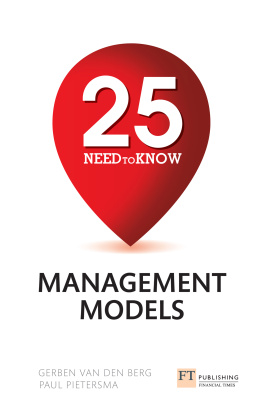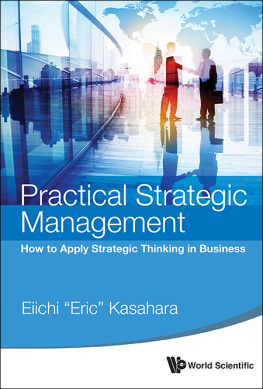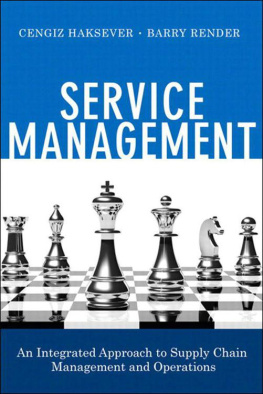Paul Pietersma - 25 need-to-know management models
Here you can read online Paul Pietersma - 25 need-to-know management models full text of the book (entire story) in english for free. Download pdf and epub, get meaning, cover and reviews about this ebook. year: 2015, publisher: FT Publishing International/Pearson, genre: Business. Description of the work, (preface) as well as reviews are available. Best literature library LitArk.com created for fans of good reading and offers a wide selection of genres:
Romance novel
Science fiction
Adventure
Detective
Science
History
Home and family
Prose
Art
Politics
Computer
Non-fiction
Religion
Business
Children
Humor
Choose a favorite category and find really read worthwhile books. Enjoy immersion in the world of imagination, feel the emotions of the characters or learn something new for yourself, make an fascinating discovery.
- Book:25 need-to-know management models
- Author:
- Publisher:FT Publishing International/Pearson
- Genre:
- Year:2015
- Rating:5 / 5
- Favourites:Add to favourites
- Your mark:
- 100
- 1
- 2
- 3
- 4
- 5
25 need-to-know management models: summary, description and annotation
We offer to read an annotation, description, summary or preface (depends on what the author of the book "25 need-to-know management models" wrote himself). If you haven't found the necessary information about the book — write in the comments, we will try to find it.
Abstract: Strategy - Organisation and governance - Finance - Marketing and sales - Operations - Innovation - Change management - Leadership and management
25 need-to-know management models — read online for free the complete book (whole text) full work
Below is the text of the book, divided by pages. System saving the place of the last page read, allows you to conveniently read the book "25 need-to-know management models" online for free, without having to search again every time where you left off. Put a bookmark, and you can go to the page where you finished reading at any time.
Font size:
Interval:
Bookmark:

Gerben van den Berg (MScBA) is a senior strategy consultant at Berenschot in the Netherlands. He has advised clients in a range of industries across Europe. In his consulting practice, his core area of work is in strategy development, competitive positioning, corporate governance and complex organisational transformation. Gerben has a special interest in professional service firms. He is the author of numerous books and articles on strategy and management that have been translated into more than ten languages, including the bestselling Key Management Models (Pearson, 2014) and the internationally well-received The 8 Steps to Strategic Success .
Paul Pietersma (MScBA MMC) is a strategy consultant and managing director of strategy, funding and innovation at Berenschot in the Netherlands. He has over 15 years experience in the consulting business, during which time he has advised many CEOs and boards of directors in a wide range of industries in the Netherlands, Belgium, Africa and the Caribbean. He has won the Dutch Professionals Award for Management Consultancy. He is the author of numerous books and articles on strategy and management, including the bestselling previous edition of Key Management Models (Pearson, 2014), the internationally well-received The 8 Steps to Strategic Success and several leading titles in Dutch.
This book is based on content from Key Management Models , first written by Steven ten Have and Wouter ten Have, alongside contributions from Frans Stevens, and developed for the second edition by Marcel van Assen, Paul Pietersma and Gerben van den Berg, and for the third edition by Gerben van den Berg and Paul Pietersma.
We are grateful to the following for permission to reproduce copyright material:
Figures after The Seven Habits of Highly Effective People , Simon & Schuster (Covey, S.R. 1989). Reprinted with permission of Franklin Covey Co.
In some instances we have been unable to trace the owners of copyright material, and we would appreciate any information that would enable us to do so.
We are currently in the midst of a dynamic, disruptive period. Virtualisation and digitalisation are on the rise and business models based on physical bricks are under siege. Unfortunately, no management model, or group of models, can guarantee a manager or consultant the perfect solution to an organisational problem. At best they will provide a new way of seeing a situation that will enable positive change to take place as a result.
Although this book is about management models, in our consulting practice we often hear phrases like, We were well prepared to face this competitor, as our analysis with the Porter model has shown us that , or, We have been very busy lowering our prices to keep up in this climate of stiff price competition, but according to the BCG analysis, we , or even, The strategic dialogue model helped us to get strong support for this decision. When events put the survival of the organisation at risk, and management is stuck running the day-to-day operational business, many people turn to management models for some common sense and information on why things turned out they way they have as if management models provide the sole truth and the ultimate solution. To us, management models are nothing more and nothing less than useful tools useful for problem solving, for analysis, for supporting and facilitating decision making and/or for improving efficiency and the effectiveness of organisations and teams. In short, management models are, in our opinion, tools for resolving common problems and challenges in business.
Models can provide valuable insights and a sound framework for making appropriate business choices. Management models and theories can help managers and consultants to gain clarity in business by reducing the complexities and uncertainties involved nothing more, but definitely nothing less.
The 20072014 crisis has made that very clear. Everybody knew that the crash in the financial system, the worldwide economic crisis, ongoing globalisation and the fact that the internet was here to stay, would mean huge challenges: different businesses, different business models and different demands on authenticity (practise what you preach), transparency (proof that you practise what you preach) and flexibility (be able to change your practice quickly). With the right type of management models, these events and their impact might have been seen upfront, and analysis and assessment of the underlying threats and possibilities of these events might help to identify what options and solutions are available to your organisation to deal with them.
However, the vast array of management models on offer can be bewildering, for managers and consultants alike. Being so commonly available, management models are used frequently. But all too often only a handful of worldwide well-known models are used for instance, models from famous authors like Michael Porter or from large firms like McKinsey & Co or Boston Consulting Group. What about all those other models. Are they unknown? Probably not, but perhaps their application is unknown. Or it might not be clear what their purpose is or in which context they can best (or cannot) be used?
Based on our book Key Management Models (Pearson, 2014), we have selected 25 need-to-know management models for you. Each model is introduced with a description, followed by an explanation of why and when to use it, what the model does and what question(s) it helps you answer.
To put it clearly: this book is intended as a top 25 of popular management models, not as a prescription for good management and organisation. It is intended as a selected anthology showing useful management models that have proven their value in practice to cope with the described challenges of our times.
It is again with both pleasure and pride that we present this compilation. We are confident that the managers and consultants who use it will possess the necessary maturity, intelligence and discernment to place the models we have included into perspective, and will use them to act on sound, creative, consistent management and advice.
We view this book as a means of giving expression to complexity, but also of making it more manageable, by providing 25 need-to-know models to simplify and visualise reality, so that management issues can be discussed based on a common language and dealt with properly and swiftly. Use the models wisely in your own specific context: structuring reality is completely different from managing reality.
To all who read this book, we wish you lots of wisdom and pleasure. Above all, we hope you achieve many constructive results from applying the models to your own organisation.
For ease of use, each management model is described as follows:
- The big picture the essence and purpose of the management model.
- When to use it the usefulness and applicability of the management model.
- How to use it a description of how to apply the management model using a step-by-step approach.
- The final analysis the limitations of the management model and the potential pitfalls with regard to its use.
- References an overview of literature sources on the origination of the management model with more information on (the use of) the management model.
Each entry includes one or more examples of how to apply the model and, where useful, includes an illustrative example which describes how the models can be used in a specific situation. Where relevant we also refer to alternative, but equally applicable, models that are included in this book, but it is certainly not our claim to be exhaustive or exclusive.
Font size:
Interval:
Bookmark:
Similar books «25 need-to-know management models»
Look at similar books to 25 need-to-know management models. We have selected literature similar in name and meaning in the hope of providing readers with more options to find new, interesting, not yet read works.
Discussion, reviews of the book 25 need-to-know management models and just readers' own opinions. Leave your comments, write what you think about the work, its meaning or the main characters. Specify what exactly you liked and what you didn't like, and why you think so.










